Podiceps auritus
IUCN
LCBasic Information
Scientific classification
- name:Podiceps auritus
- Scientific Name:Podiceps auritus,Horned Grebe,Slavonian Grebe
- Outline:Waterfowl
- Family:
Vital signs
- length:36.6-39CM
- Weight:245-500g
- lifetime:No textual research information is available
Feature
Distribution and Habitat
Grebe breeds in Europe, Asia and northern North America, from Iceland and the Faroe Islands in the west, through Norway, Sweden, Denmark, Finland, the North Sea, the Baltic Sea, Belarus, European part of Russia, Kazakhstan and northwestern Xinjiang of China, Siberia, south to the Altai and Baikal, to the Far eastern coast of Russia, Sakhalin Island, Kamchatka Peninsula. And then across the Bering Sea to northern North America. Wintering in southern Europe, the North Sea, the Aral Sea, the Caspian Sea, Japan, Korea, the Aleutian Islands, California, the Atlantic coast to Mexico and the lower Yangtze River of China to Fujian, and occasionally Taiwan. During the migration, it passed through Heilongjiang, Jilin, Liaoning, Hebei, Henan, Shandong and other provinces.
Distribution in China: Northwest Xinjiang (west of Tianshan Mountains), northeast Harbin, Lushun, North China Hebei, Henan, Shandong, the lower reaches of the Yangtze River Fujian, Taiwan.
Native distribution: , Kyrgyzsta
Appearance
Great horned grebe black summer head, nape and upper body, metallic luster; Dorsal and shoulder feather margins are light brown; From the eye first, through the eye to the back of the eye a prolonged ochre maroon and golden yellow ear feathers located on both sides of the head, like two "horns" protruding from the head; The front neck, upper chest and two chestnuts are red, the rest of the lower body is white; Underwing coverings are white, wing edges are brown, upper wing coverings are grayish-brown, inner large coverings are white, with blackish-brown spots; The primary flight feathers are brown, with black feather axes and inner white base, the outer secondary flight feathers are white, with brown patches, the middle secondary flight feathers are pure white, the inner secondary flight feathers are black and the base is white.
Winter feathers from the corners of the mouth along the top of the head above the eyes, the back of the neck, the back, the waist and the wings co
Details
Horned grebe (pit) Podiceps auritus (foreign name Horned Grebe, Slavonian Grebe), as for subspecies differentiation, some scholars think that the species distributed in Europe and Asia is darker than the North American population, the head and back are more black and less gray, thus dividing this species into two subspecies. The horned grebe named subspecies P.A.Alitus (Linnaeus, 1758) and the horned grebe North American subspecies P.A.Calnutus (Gmelin, 1789). However, because the differences between the two subspecies are quite slight and extremely unstable, most scholars do not support this view. In China, only a named subspecies is found in Beijing, Hebei, Liaoning, Jilin, Heilongjiang, Shanghai, Jiangsu, Zhejiang, Fujian, Taiwan, Shandong, Henan, Hunan, Xinjiang and other regions.
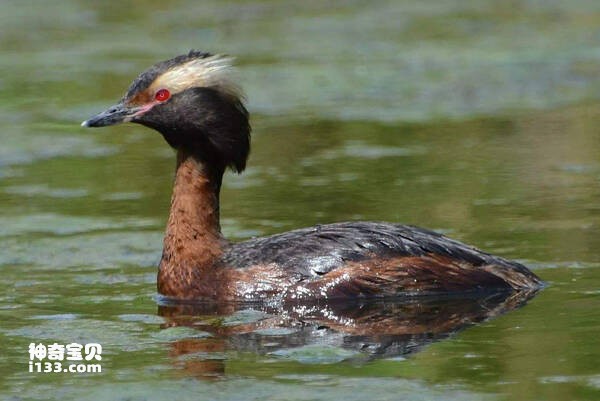
The horned grebe is often solitary and in pairs, and small groups of 4 to 12 individuals can be found during migration and winter. Active during the day, rest in the water. Good at swimming and diving, often head down into the water, and then complete a beautiful forward roll action, and then do a high-speed underwater swimming, and then far away from the surface of the water, each diving time is more than 20 to 30 seconds, the longest can stay underwater about 50 seconds. When swimming, the neck is kept straight up, usually perpendicular to the water. Flying ability is stronger than other Grebe, takeoff is also easier and more flexible than other grebe, when taking off on the water, first run close to the water before lift-off, feet on the water splash a string of waves, usually by flying away in case of danger. When flying, the two wings are very strong, mostly in a straight line, and the speed is fast. Walking on the land is not flexible, because the position of the two legs is too far back, it is almost difficult to walk.
The horned grebe mainly feeds on a variety of small fish, aquatic insects, insect larvae, crustaceans, mollusks, crayfish, frogs, tadpoles and other aquatic animals, as well as a small amount of plant seeds, grasses and aquatic plants. They eat more insects in summer and fish and crustaceans in winter. The main way to find food is through diving. Foraging activities are more frequent during the day, especially in the early morning and afternoon. Sometimes, the grebe will also eat their feathers, possibly to help digest fish bones in the stomach, possibly to remove parasites from the gut, and even to feed their chicks. The non-breeding season is silent. The tremolo duet is grebe but nasally; Also has a gruff, guttural cry.
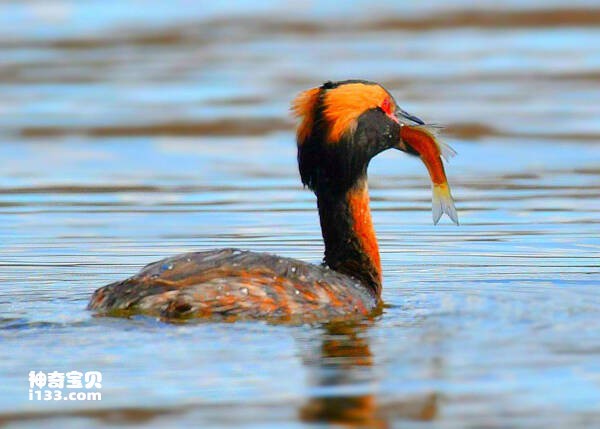
The horned Grebe begins to migrate north from early April to late April in spring and to wintering grounds in China from late October to early November in autumn. Migration is slow and takes place mainly along coasts and rivers. It often migrates in pairs or small groups, occasionally migrating alone.
Breeding period May to August, every summer, the horned grebe begins to enter the breeding period. They mate not only during the day, but often at night when the moon is dim. The performance of both sexes when estrus is very complex, rich and colorful, of which the shaking of the head is the most common action, as well as the reed, with the mouth preening feathers, show wings, etc., sometimes male and female birds first face each other, and then thrust into the water together, after a moment to surface, with a pinch of water grass in their mouths, and then face to face, and shake their heads; Sometimes they dance on the calm water, performing a complex water ballet.
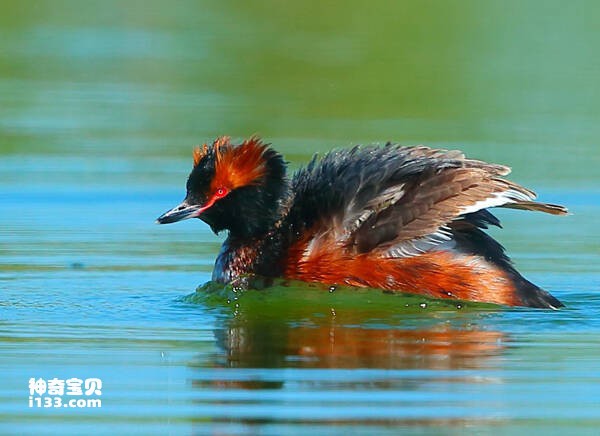
The nests of the horned grebe are found in areas of open tundra and forests where aquatic plants flourish, such as reeds or water bushes in small lakes and ponds, as well as on sheltered stream banks. They often breed in single pairs, occasionally in large lakes where they nest separately or in small groups. Their nests are relatively large, floating on the water like a small boat, called floating nests. The nest is built by water-living plants, first bend some water grass and reed as the base of the nest, and then use reed leaves and other aquatic plant leaves piled on the top, the middle is slightly depressed, it is very tight and strong, not only does not seep water, and can rise and fall with the water level, so when the water rises, the eggs or young birds in the nest will not be soaked by water. In addition, because the aquatic plants that make the nest produce heat, it also helps the eggs hatch. To build a nest, the male and female work together, diving into the water again and again to retrieve the nest material.
Eggs are laid in mid-May each year, usually 4 to 5, occasionally 3 to 6, in northern Europe and North America even up to 8 or 9 to 10. The eggs are oval, smooth and non-spotted, with a light white or light green luster, and gradually become dirty white after incubation, or become black yellow due to long-term immersion in the rotten grass nest, the eggs weigh about 20 grams, the size of 29.1 ~ 31mm × 41.3-49.8mm, with an average of 30.73mm × 44.5mm. After the first egg is produced, the parent birds begin to hatch, and the incubation is borne by the male and the female birds in turn, mainly the female birds, and the incubation period is 20 to 25 days. Whenever both male and female birds go out for food, they cover the eggs with water grass to keep them warm and prevent predators from preying on them.
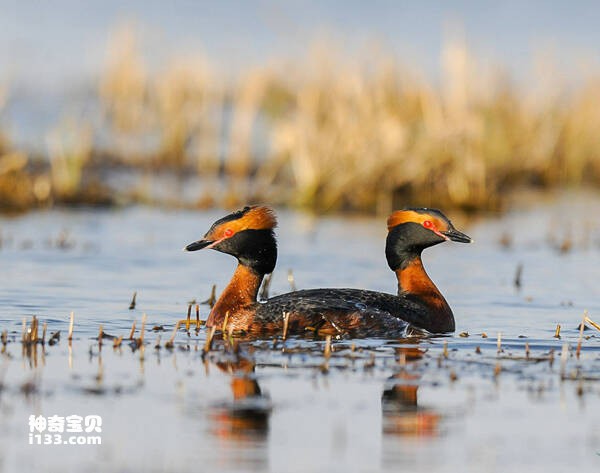
The hatchling grebe chick is covered in downy hair and has a few brown streaks on its neck, quite different from the plumage of its parents. When the chicks emerge from their shells, the males and females work together to nurture them. When swimming in the water, the parent birds often let the chicks crawl on their backs, feeding and playing in the water, which is very interesting. Soon after the shell, the parent bird began to teach the baby bird to practice swimming, they will suddenly dive into the water, so that the baby bird on the back has to swim alone on the surface of the water forward, and then the parent bird again on the back, so repeated, the baby bird soon became familiar with water, can freely follow the parent bird swimming for food. When confronted with an enemy, the parent birds carry the chicks on their backs and flee, or hide them under their wings and dive away. Parent birds also often peck at their own feathers to feed their chicks, and the feathers that form in their stomachs or break down in their stomachs can help with digestion.
The horned grebe is not common in China and its population is small. According to the surveys of Asian midwinter waterbirds organized by the International Waterfowl Research Bureau in 1990 and 1992, only 60 were seen in China in 1990 and 30 in 1992. In 1990, 61 individuals were seen in East Asia, 81 in West Asia and 37 in East Asia. In 2006, Wetlands International estimated the global population of Grebe to be between 140,000 and 1,100,000 individuals. In 2009, estimates from some countries were as follows: 50 to 1,000 grebe migrating to China and no more than 50 wintering in China; 100-100,000 pairs of adult birds and 50-10,000 individuals migrate to Russia.
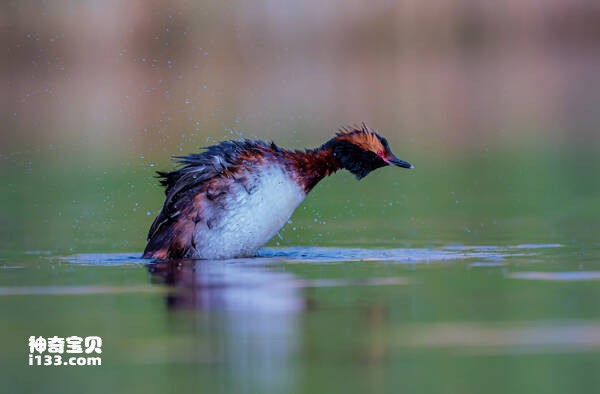
The main threats to the grebe population are human interference (hunting is not a major risk factor), forestry and agricultural activities around breeding lakes, such as afforestation resulting in hydrological changes such as fluctuations in lake levels, and the use of pesticides in agriculture resulting in reduced prey. The historical range of the horned grebe is shrinking due to water eutrophication due to lake acidification and increased humus. Accidental drowning due to entanglement in fishing nets and oil spills in the ocean are also risk factors for the horned grebe population.
On November 22, 2019, the horned Grebe, a national second-class protected animal, was observed for the first time in Ningxia. On January 4, 2023, it was learned from Jiangxi Poyang Lake National Nature Reserve Administration that a national second-class protected animal, horngrebe, was found in Jishan waters of Poyang Lake during the daily patrol by staff of Duchang Station of Poyang Lake Reserve Administration. This is the first record of this species found in Poyang Lake Reserve.
It has been listed in China's "National Secondary Key Protected Wildlife List" (1988).
It is listed in the International Union for Conservation of Nature (IUCN) Red List of Threatened Species ver3.1 (2012) - Species not Threatened (LC).
Protect wild animals and eliminate wild meat.
Maintaining ecological balance is everyone's responsibility!








